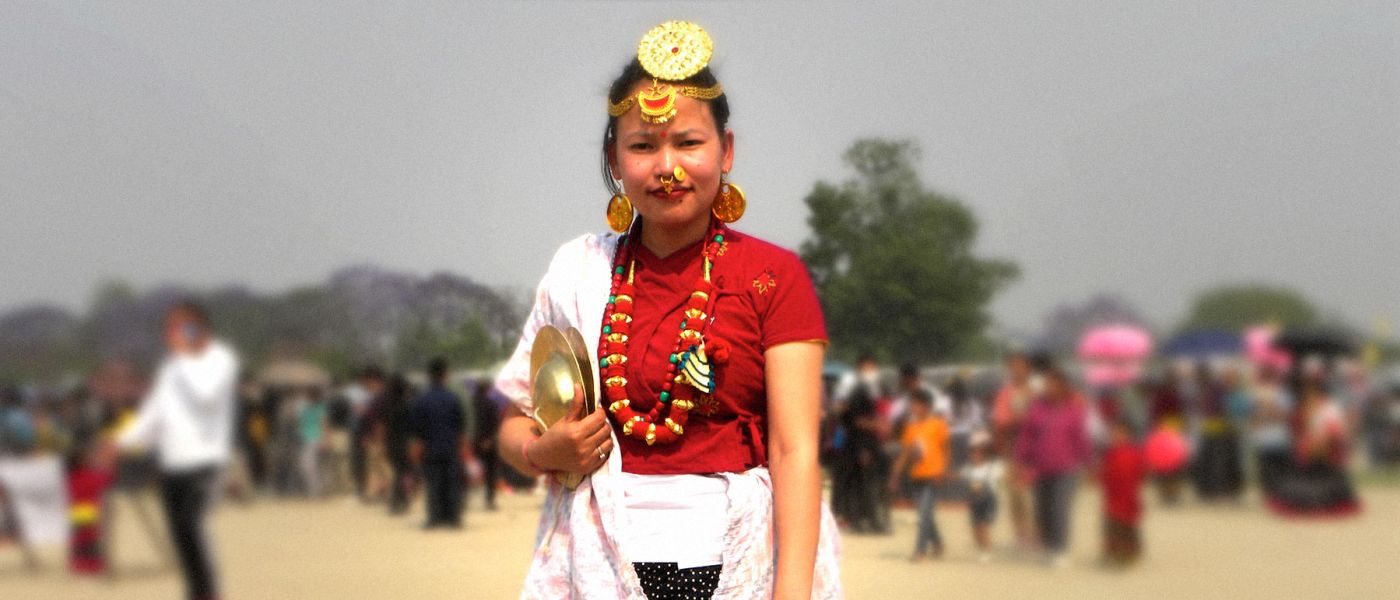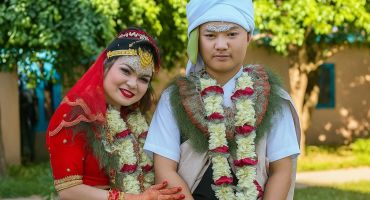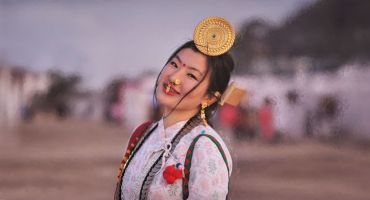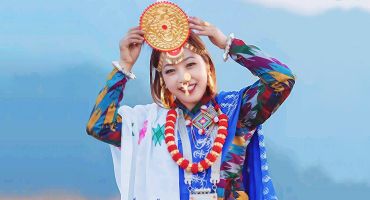Within the social fabric of the Kirati Khambu Rai people, music has metamorphosed into a space for cultural discourse. It engages both performers and audiences, facilitating discussions about their heritage and personal encounters. It is also a part of their elaborate rituals. In addition to language, musical and religious behaviors exhibit a notable universality among modern humans. It is no different among the Khambu Rai people, where ritual songs seem to function as a catalyst for molding social landscapes, with the power to harmonize emotions, define social ties, conduct rites, and cultivate collective identities. As a result, it has emerged not just as an integral part of Kirat Khambu Rai culture and rituals but as a platform for recognizing and reconciling identities, driven by its multifarious nature.
A song is called Cham, which is an indispensable component of the Mundhum (traditions, rituals, and oral narrative of the Kirati Khambu Rai people), deeply intertwined with the Khambu way of life. Khambus actively engage in musical pursuits within their households, at marketplaces, and particularly during social gatherings, with a heightened presence during various rituals. Beyond mere entertainment, music assumes a central role in their social, religious, and ceremonial spheres. It serves several purposes, encompassing the realms of healing, assisting in daily chores, bolstering agricultural endeavors, accompanying essential life events such as weddings and funerals, and infusing vibrancy into festivals. For the Khambu Rai community, music isn’t merely an artistic medium but a profound means of conveying love and emotions. Consequently, ritual songs, deeply rooted in the Mundhum, constitute an integral facet of the Kirat Rai cultural narrative.

At the forefront of ritual songs is the Khambu Shamanic incantation. Also referred to as Rungpu Rishiwa or Rishiwa Bagbuipa, this segment of the Mundhum text is sung by various categories of Shamans, including Mangpa, Nakchhong, Nachhong, and Nokso. Typically, they recite the Mundhum while accompanied by the sounds of drums, cymbals, or the resonant tones of the clanging of brass plates. During this ritual, they may also enter into a trance-like state, establishing a profound connection with divine spirits on a spiritual plane. Although the Mundhum includes Boptomi Selemi, a sequence of ritual oratory recited by a Dowa or the family’s leader during ceremonies, it typically lacks any musical tune or melody. Rishiwa, however, resonates with a captivating tune, characterized by a distinct melodic quality while maintaining consistent rhythmic stability.
Pitch and intonation play essential roles in Khambu Rai ceremonial Shamanic chants. The music inherent to the Mundum language possesses a unique and uncommon essence. Diverging sharply from contemporary musical genres, it is a form of traditional tribal music exclusively employed within the context of Mundum rituals. While Shamanic songs inherently contain melody, it is the ritual language utilized in Mundhum songs that emphasizes particular melodic patterns. One can notice that the Mundum ritual language exhibits innate rhythmic, melodious, and poetic attributes, predominantly attributed to its inherent structural characteristics and the organization of rhyming binomials within it. Furthermore, the Khambu ritual speech is itself phonetically melodic in nature. For instance,
“Dongwanga, dongdawa, dongwanga dongdawa khida,
Sayachoksa, Wayaloksa banthen yetsa,
Nammang, Naamang, Chhinmang, Chhinmang lisa..”
“As the seasons change from winter to spring, spring to winter,
It is these changing seasons that give,
So all sentient beings continuously live..”
The comprehensive essence of Rishiwa, the potent vocals of the Shaman, and the resonating clangs are believed to possess the ability to embrace the energies of the unseen realm within the spiritual domain. In fact, the distinction between individuals and their environment, particularly among those engaged in the ceremony, seems to dissolve during rituals. These songs become defining features of a ritual. It becomes evident that Khambu ritual music serves to fulfill several crucial purposes: it orchestrates the ceremony, facilitates the reunion of family members, and revitalizes the essential life force (Saya) and physical aspects of reality.
Undoubtedly, the Kirat Khambu Rai community possesses unique indigenous frameworks to navigate metaphysical and epistemological facets of their culture and religion. Despite the encroachment of modernity, these systems have endured, primarily transmitted through oral traditions. These systems are embedded within the 29 Rai languages, encompassing both specialized and everyday dialects. In addition to ritualistic songs found in specialized linguistic forms, there are other genres designed to preserve the cultural narrative of indigenous knowledge systems, such as the Hopmacham.

Hopmacham is not classified as a shamanic genre, yet it holds a divine significance and is performed during specific rituals. The term “Hopmacham” is derived from “Hopma,” which translates to “to drink,” and “Cham,” which means “song.” However, it’s important to note that it doesn’t imply that it’s sung when someone is inebriated. While the consumption of Millet Beer (Charima Wasim) is a fundamental aspect of Khambu rituals, Hopmacham is a song that has the ability to evoke a sense of intoxication through its inherent power.
Anthropologist Martin Gaenszle writes, “The Hopmacham is not a shamanic genre, and it is not sung for the purpose of healing. Yet it is regarded as possessing a special kind of efficacy, a kind of magic. It is commonly explained, for example, that it can bring rain in the case of drought, it can bring life to dead trees, it can charm animals and trees, it can even light fire, and above all, it can evoke intense emotions, both sadness, and happiness, in the listeners. But at the same time, it is seen as dangerous for the performer because, if not sung properly, with adequate competence, the singer can become ill – or even die.”
Hopmacham is sung during events that evoke a profound connection with deceased ancestors. It means that in various Khambu Rai rituals where the ancestral spirits are invoked, this song serves as a medium that links ordinary individuals without any shamanic abilities to their ancestors. Traditionally, Hopmacham is performed after Sakela festivities and also at wedding ceremonies. Hopmacham is fundamentally the melody of nature, resonating in harmony with the natural frequencies of the universe. It is believed to be comprehensible to all living creatures, including plants and flowers.
In Kirati Rai culture, music serves as the vital link between the spirit realm and the community. The primary purpose of musical performances is typically rooted in spirituality. Shamans employ music as a method of conveying guidance for healing or addressing collective crises, benefiting both individuals and the community. However, music also plays a significant role in expressing the emotions and, most significantly, the beliefs of the Kirati Khambu Rai people. It strongly influences their cultural customs. Beyond its customary ritualistic function, music holds an essential place in Khambu Rai social life. The following are some of the various musical genres that are an integral part of the Khambu community.
Hiya Cham: Festive Singing
This particular song, known as “Hiya Cham,” is typically performed during wedding ceremonies. Those accompanying the bride and groom sing this song, symbolically representing the couple.
Saima Cham: Joyous Duet
“Saima Cham” features a male and a female taking turns singing. The lyrics may revolve around themes of love, and the overall tone can carry flirtatious undertones. This song is commonly sung during festive occasions, especially during the spring and fall festivals of Sakela.
Bukundi Cham: Forest Resonance
“Bukundi Cham” differs from traditional Cham songs, as it involves shouting in a musical manner. When Khambus are out collecting firewood or cutting grass in the forest, they may wander off, leaving their friends behind. After a while, as one takes a break, they may realize they are alone. To ensure their friends are nearby and to alleviate any fear, they shout out a specific song. If a friend hears the call, they continue with the song, setting off a relay that serves to confirm their presence and dispel any sense of isolation.
Musical Instruments (Kane)
The following are the everyday instruments that the Khambus use for the accompaniment of songs or a worship ritual:
Chhamchong Kane – Large Drum beaten by sticks
Sumni Kane – Cymbals
Chhenbi Kane – Tossing of Coins for Percussion
Samba Kane (Yalambar Baaja) – Bamboo Drum
Dong Kane (Binayo) – Slit Bamboo Mouth Instrument
Karu Kane (Murchunga) – Jew’s Harp
Bibilima Kane – Flute
Phoppi Kane – Slit Bamboo Blow Instrument
Sili Kane – Percussion Instrument used during Sili Dance
Sumbak Kane –Leaf
Suipasang Kane –Whistle
Pung Kane – Buffalo Horn
Chhowa Kane – Pan Flute





Leave a Reply